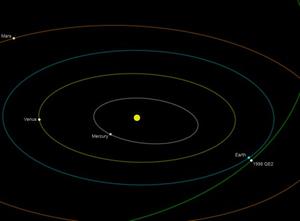Planetary securityAsteroid 1998 QE2, nine times larger than cruise ship, to glide past earth
Two weeks from now, on 31May 2013, asteroid 1998 QE2 will sail serenely past Earth, getting no closer than about 3.6 million miles, or about fifteen times the distance between Earth and the moon. While QE2 is not of much interest to those astronomers and scientists on the lookout for hazardous asteroids, other asteroids are. NASA recently announced developing a first-ever mission to identify, capture, and relocate an asteroid for human exploration.

1998 QE2's orbit will bring a fly-by at 3.6 million miles // Source: jpl.nasa.gov
Two weeks from now, on 31May 2013, asteroid 1998 QE2 will sail serenely past Earth, getting no closer than about 3.6 million miles, or about fifteen times the distance between Earth and the moon. While QE2 is not of much interest to those astronomers and scientists on the lookout for hazardous asteroids, it is of interest to those who dabble in radar astronomy and have a 230-foot — or larger — radar telescope at their disposal.
“Asteroid 1998 QE2 will be an outstanding radar imaging target at Goldstone and Arecibo and we expect to obtain a series of high-resolution images that could reveal a wealth of surface features,” said radar astronomer Lance Benner, the principal investigator for the Goldstone radar observations from NASA’s Jet Propulsion Laboratory in Pasadena, California. “Whenever an asteroid approaches this closely, it provides an important scientific opportunity to study it in detail to understand its size, shape, rotation, surface features, and what they can tell us about its origin. We will also use new radar measurements of the asteroid’s distance and velocity to improve our calculation of its orbit and compute its motion farther into the future than we could otherwise.”
A NASA release reports that the closest approach of the asteroid occurs on 31 May at 1:59 p.m. Pacific (4:59 p.m. Eastern / 20:59 UTC).
This is the closest approach the asteroid will make to Earth for at least the next two centuries. Asteroid 1998 QE2 was discovered on 19 August 1998, by the Massachusetts Institute of Technology Lincoln Near Earth Asteroid Research (LINEAR) program near Socorro, New Mexico.
The asteroid, which is believed to be about 1.7 miles, or nine Queen Elizabeth 2 ship-lengths, in size, is not named after that 12-decked, transatlantic-crossing flagship for the Cunard Line.
Instead, the name is assigned by the NASA-supported Minor Planet Center in Cambridge, Massachusetts, which gives each newly discovered asteroid a provisional designation starting with the year of first detection, along with an alphanumeric code indicating the half-month it was discovered, and the sequence within that half-month.
Radar images from the Goldstone antenna could resolve features on the asteroid as small as twelve feet across, even from four million miles away.
“It is tremendously exciting to see detailed images of this asteroid for the first time,” said Benner. “With radar we can transform an object from a point of light into a small world with its own unique set of characteristics. In a
